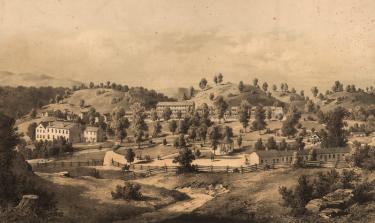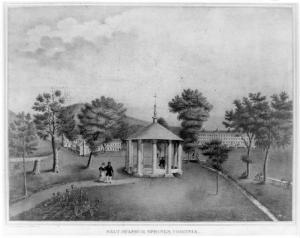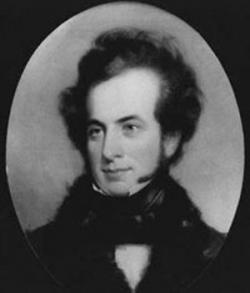Salt Sulphur Springs
Monroe County, West Virginia
If order, abundant and well prepared fare, excellent bedding, quiet and obliging domestics, impartial and gentlemanly efforts to promote health and comfort, have any influence upon public favor, the proprietors of the Salt Sulphur will certainly secure it. William Burke

Edward Beyer’s print of Salt Sulphur Springs published in 1857. {1}
William Burke on the Salt Sulphur Springs.
The Salt Sulphur Springs are located in Monroe County in what is now West Virginia, and were the subject of an 1840 pamphlet by Thomas D. Mütter titled The Salt Sulphur Springs, Monroe County, Virginia. Writing that it would be presumptive of him to discuss a subject already undertaken by the distinguished Dr. Mütter, soon to become Chairman of the Department of Surgery at Jefferson Medical College in Philadelphia, Dr. Burke instead included several chapters from Mütter’s pamphlet. Mütter wrote that there were three springs surrounded by mountains at the Salt Sulphur. The first spring was discovered in 1802 or 1803 by a man boring for salt and enjoyed early fame until 1805 when the observation of herds of deer and buffalo at a natural salt lick led to the discovery of the second. Eventually analyzed by University of Virginia Professor William B. Rogers, it was the first in which he detected iodine. The third spring, found in 1838 while cutting a drain for water from the second, was warmer than the others but similar in taste and smell. Each of the three springs was enclosed in a square marble reservoir, and all had structures of some variety over them.
Burke did not want to leave unnoticed the “amiable” proprietors, Mr. Erskine and Mr. Caruthers, and gave them high praise for the “sumptuous provision” they made for their guests who were “treated as princes.” While quoting the “distinguished” Dr. Mütter extensively, Burke was also willing to contradict his assessment of the unique qualities of temperature and humidity of the location when he wrote that Dr. Mütter’s “alleged superiority of climate is altogether imaginary.”
Burke’s Recommendations for Using the Waters at Salt Sulphur Springs.
Dr. Burke again relied on Dr. Mütter’s pamphlet to describe diseases helped by the Salt Sulphur Springs. The waters were best avoided in acute or highly inflammatory afflictions, but were judged useful in chronic problems involving the brain or nervous system such as neuralgia, hysteria, incipient mania, and chorea. They were among the most valuable remedial agents in “some diseases of the lungs, stomach, bowels, liver, spleen, kidneys, and bladder,” but Mütter also warned that using a stimulant as active as the Salt Sulphur water could hasten the death of certain pulmonary patients. The springs were deemed a “remedy of immense importance” in gout, rheumatism, skin disorders, mercury poisoning, hemorrhoids, and chronic diseases of the womb.
Dr. Burke Concerning Professor Rogers’ Analysis of the Third Spring.
“In the analysis he gives: Iodine—a trace! We confess we cannot understand how a trace can be much greater than the quantity he has been so fortunate as to find in other waters. It may be owing to our obtuseness in not being able to distinguish between a large trace and a small trace; but we have always considered the difference to be about the same as between the big end of nothing, and the little end of no-thing-at-all.” {Burke, 334}
Dr. Thomas Dent Mütter.
Dr. Mütter (1811-1859) visited the Virginia springs in 1834 as a consequence of “feeble” health. While he toured this “health-restoring region” he sought to ascertain the merits of the different waters with the intent of publishing a “small work.” He gave up this idea as various engagements intervened. But in the summer of 1839 he was again obliged to visit the springs due to ill health. His earlier observations were confirmed, and he decided to write a pamphlet for each of the waters with the relative merits of the therapeutic influence of each. He chose to publish his first pamphlet, The Salt Sulphur Springs, Monroe County, Virginia, on, “a spring as yet little known among us, but whose sanative influence in many diseases cannot fail to establish for it ere long a reputation of the highest order.” This pamphlet was published in 1840 and may have been not only the first, but also the only pamphlet by Mütter on the springs as the following year he became the third Chairman of the Department of Surgery at Jefferson Medical College, a position he held until 1856. Mütter bequeathed his unusual anatomical and pathological specimens, a total of 1700 items, to the College of Physicians of Philadelphia, together with an endowment of $30,000 for maintenance and a lectureship associated with the collection. The Mütter Museum now includes over 20,000 objects.
More Information:
- National Register of Historic Places Nomination Form: This detailed form for the Salt Sulphur Springs is dated August 1974. It includes the history and significance of the springs, descriptions of surviving buildings and ruins, maps, a bibliography, and photographs.
- National Register of Historic Places: The National Register has a brief summary of places in Monroe County, West Virginia.
- Monroe County official tourism site, culture and history: This site states that Salt Sulphur Springs has the largest complex of stone buildings in West Virginia.
- WV Your Way: The Salt Sulphur Springs guest house is a pre-Civil War stone house on the property of the old Salt Sulphur resort and may be rented for overnight stays.
- Library of Congress Prints & Photographs Online Catalog: Search for Salt Sulphur, and see 16 images of Salt Sulphur Springs.
Image Credits:
- {1} Merritt T. Cooke Memorial Virginia Print Collection, 1857-1907, Accession #9408, Special Collections, University of Virginia Library.
- {2} Library of Congress Prints & Photographs Online Catalog, Accessed April 22, 2010.
- {3} Thomas Mütter Collection, Courtesy of the Thomas Jefferson University Archives and Special Collections (Art/Photo Collection, AM-097).
Sources:
- William Burke, The Mineral Springs of Western Virginia, New York: Wiley and Putnam, 1846.
- Thomas D. Mütter, The Salt Sulphur Springs, Monroe County, Virginia, Philadelphia: T.K. & P.G. Collins, 1840.

